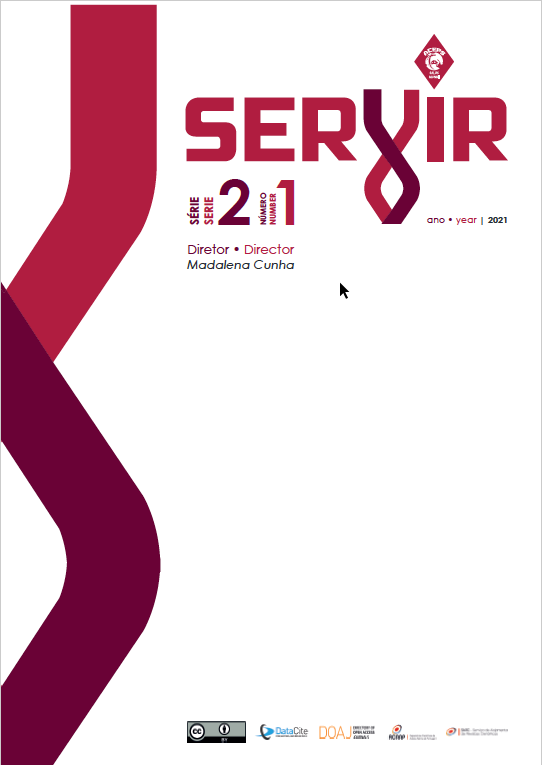Agrochemicals and suicide
an epidemiological emergency?
DOI:
https://doi.org/10.48492/servir0201.25678Keywords:
agriculture, agrochemicals, depression, suicideAbstract
Introduction: Suicide is a self-destructive behaviour considered as the act of intentionally causing one’s own death, constituting a serious public health problem. Depression and social, economic and cultural aspects are some of the predisposing factors for suicidal behaviour. The growing use of agrotoxics inagriculture constitutes a precursor of the occurrence of suicide by poisoning.
Objective: To analyse the correlation between the use of agrochemicals and the occurrence of suicide.
Methods: Exploratory study performed in a sample constituted by 53 deaths investigated as suicide among the population of Arapiraca, in the period between 2007 and 2013, which registered an average of 7.6 deaths per year (75.5% males and 24.5% females). Data collection was supported by the Record of Deaths by suicide (Registo de Óbitos por suicídio) SIM - codes X60 to X84-Chapter 20-CID-10, out of the DATASUS/ MS database, and in surveying the 53suicide victims’ families.
Results: The suicidal individuals were aged between 14 and 89 years old, 32.1% presented symptoms of depression, 35.8% worked with agrochemicals and 30.2% used them in agriculture. Findings showed that 32.1% of the suicidal people were in a depressive state (Fischer p=0.001), had previously tried tocommit suicide and used pesticides to carry out the act (30.2%).
Conclusion: There is a need for new studies on this problem, mainly with the purpose of ascertaining whether or not there is a correlation between exposureto agrotoxics and suicide, given that most suicidal people’s occupation over the period under study was agriculture, in which the indiscriminate use of thesechemicals was established. Our findings support that screening both depression and professional/social aspects is of crucial importance in order to promotepositive mental health and prevent suicide.
Downloads
References
Agroquímicos. (2015). Biblioteca Virtual em Saúde – DeCS. Acedido em Dezembro,02, 2015 em http://decs.bvs.br/cgi-bin/wxis1660.exe/decsserver/
Ahmed, S., Hussain, M., Virani, S., Dar, S., Sreeram, V., Ahmed, R., Gill, M. (2015). Suicide: A complex phenomenon, risk assessment, a dilemma of emergency. Journal of Addiction Research & Therapy, 6(3), 1-6. http://www.omicsonline.org/open-access/suicide-a-complex-phenomenon-risk-assessment-a-dilemma-of-emergency-room-physicians-2155-6105-1000245.pdf
Bertolote, J., Mello-Santos, C., & Botega, N. (2010). Deteção do risco de suicídio nos serviços de emergência psiquiátrica. Revista Brasileira de Psiquiatria, 32(Suppl. 2), S87-S95. http://www.scielo.br/scielo.php?script=sci_arttext&pid=S1516-44462010000600005&lng=en&tlng=pt
Botega, N. J. (2014). Suicidal behavior: Epidemiology. Psicologia USP, 25(3), 231-236. doi:10.1590/0103-6564D20140004
Conselho Internacional de Enfermeiros. (2011). CIPE: Versão 2: Classificação Internacional para a prática de enfermagem. Lisboa: Ordem dos Enfermeiros. http://associacaoamigosdagrandeidade.com/wp-content/uploads/filebase/guias-manuais/ORDEM%20ENFERMEIROS%20cipe.pdf
Machado, D., & Santos, D. (2015). Suicídio no Brasil, de 2000 a 2012. Jornal Brasileiro de Psiquiatria, 64(1), 45-54. doi:10.1590/0047-2085000000056
Matos, A. (2013). Análise das intoxicações exógenas por agrotóxicos no Brasil, entre 2007 e 2012 (Trabalho de conclusão de Curso, Universidade de Brasília). http://bdm.unb.br/bitstream/10483/6913/1/2013_AntonioDaSilvaMatos.pdf
Neto, M. G. (2014). Intoxicação por agrotóxicos e surgimento de depressão: Um estudo de caso. http://portalbiocursos.com.br/ohs/data/docs/21/47_-_IntoxicaYYo_por_agrotYxicos_e_surgimento_de_depressYo_um_estudo_de_caso.pdf
Organização Mundial de Saúde. (2006). Prevenção do suicídio: Um recurso para conselheiros. Genebra: Suíça. Organização Mundial de Saúde. (2014). Prevenção do suicídio: Um imperativo global. Genebra: Suíça.
Rodrigues, R. P., Sá, M. C., & Moura, D. (2011). Internamentos por intoxicação com pesticidas em Portugal. Arquivos de Medicina, 25(5-6), 169-173. http://www.scielo.mec.pt/scielo.php?script=sci_arttext&pid=S0871-34132011000500001&lng=pt&tlng=pt
Santos, J. A. T., Seleghim, M. R., Nerilo, S. B., Fernandez, L. S., & Oliveira, M. L. F. (2015). Inseticidas organofosforados e intoxicação humana: Uma revisão da produção científica sobre o tema. SaBios: Revista de Saúde e Biologia, 10(2), 54-65
Santos, S., Legay, L., Aguiar, F., Lovosi, G., Abelha, L., & Oliveira, S. (2014). Tentativas e suicídios por intoxicação exógena no Rio de Janeiro, Brasil: Análise das informações através do linkage probabilístico. Cadernos de Saúde Pública, 30(5), 1057-1066.
Silveira, R. (2010). Perfil epidemiológico do suicídio em um município do interior mineiro. http://www.webartigos.com/artigos/perfil-epidemiologico-do-suicidio-em-um-municipio-do-interior-mineiro/31609/
Vidal, C., Gontijo, E., & Lima, L. (2013). Tentativas de suicídio: Fatores prognósticos e estimativa do excesso de mortalidade. Cadernos de Saúde Coletiva, 29(1), 175-187
Vidal, C., Gomes, C., Mariano, C., Leite, M., Silva, R., & Lasmar, S. (2014). Perfil epidemiológico do suicídio na microrregião de Barbacena, Minas Gerais, no período de 1997 a 2012. Cadernos de Saúde Coletiva, 22(2), 158-64
Downloads
Published
How to Cite
Issue
Section
License
In order to promote the free circulation of knowledge, Servir is open access journal. All its content is available and protected under the Creative Commons license (CC BY 4.0).
The journal allows self-archiving in institutional repositories of all versions, which may become immediately available


